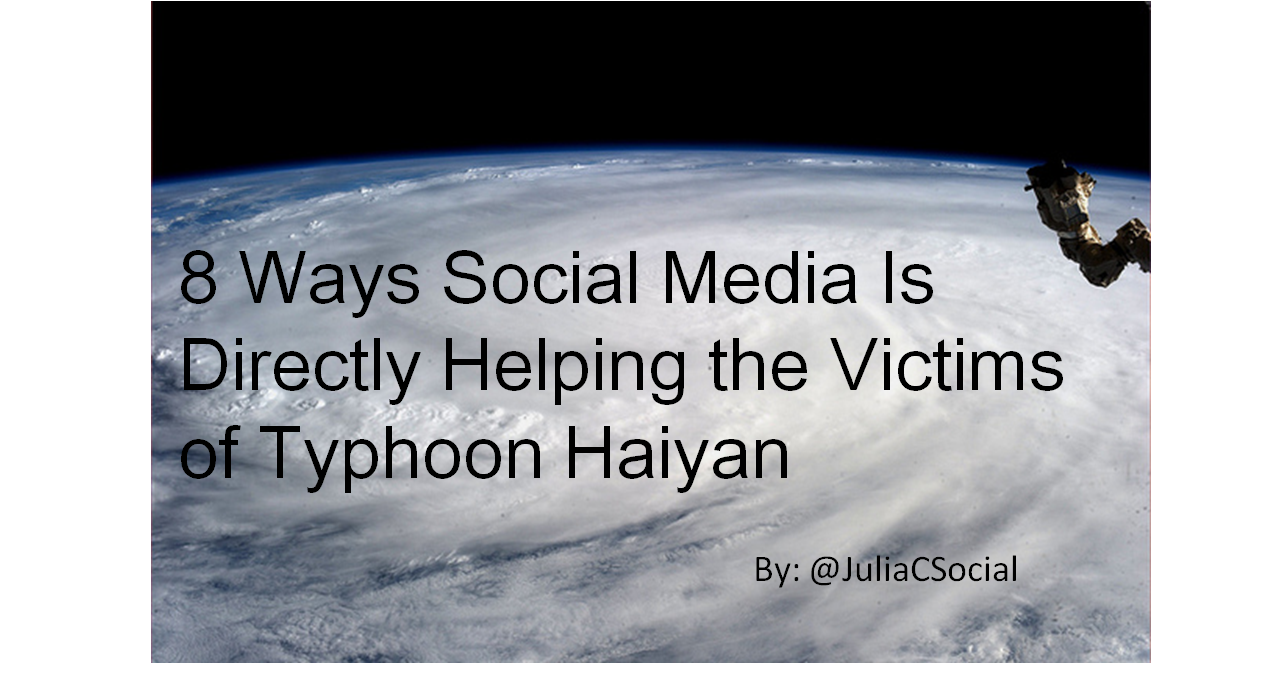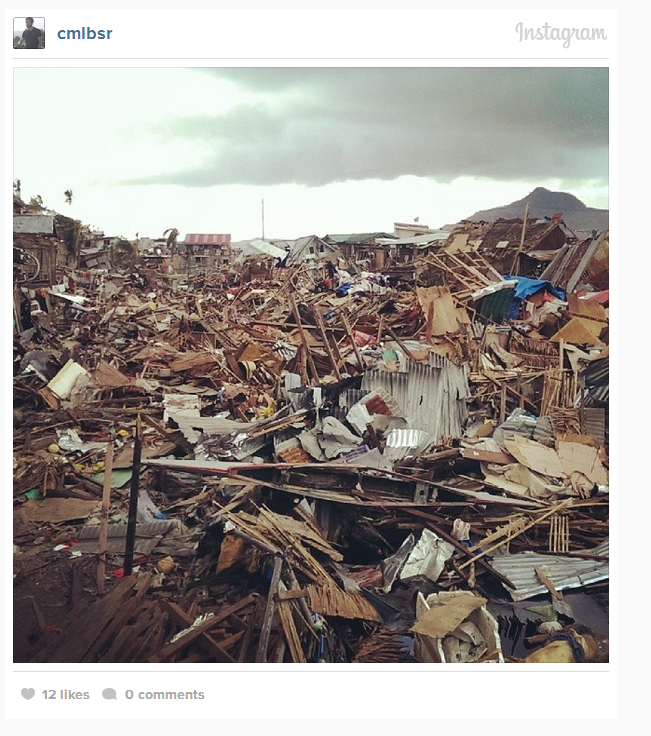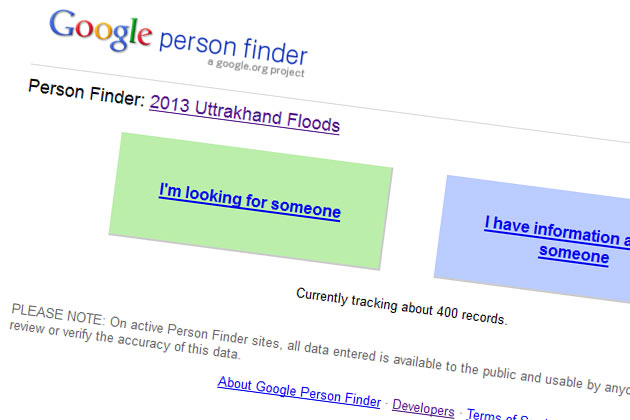 By now you have heard of the complete devastation in the Philippines wrought by Supertyphoon Haiyan.
By now you have heard of the complete devastation in the Philippines wrought by Supertyphoon Haiyan.
According to CNN, nationwide the death toll from the typhoon stands at 3,976 with another 1,598 missing.
Most likely you heard something about this tragedy via social media. Maybe you donated money to one of the many emergency relief funds set up in the wake of the disaster.
Some people continue to lambast social media as worthless for nonprofits, criticizing so-called “slacktivists” for sharing information passively. I completely reject that notion.
Here are 8 ways that social media and online tools have directly contributed to raising money for the emergency response and in some cases, the saving of lives, after Supertyphoon Haiyan.
1) People posted calls for help and responses to these calls. After Haiyan hit, survivors used their smartphones to let the world know they were ok, to post their locations and to describe the situation on the ground. Filipina Mai Arnaiz Jardeleza-Cataquiz sent out a call for help via Facebook, tagging a journalist to get attention for her small municipality Estancia.
2) Find missing people. Survivors and others worldwide can use Google’s free crisis tool Google Person Finder to post and search for the status of loved ones. The Typhoon Yolanda Relief Map gives updates on shelters and other news in the worst hit areas.
3) Plan relief efforts. Patrick Meier of Qatar Foundation’s Computing Research Institute in Qatar develops online tools like MicroMappers to sort through all of the tweets, posts, pins and photos online to get a better sense of a the disaster at hand. The technology uses the collected and sifted through social media data to create rich digital maps that are then used by aid agencies to create a better, more efficient plan for disseminating resources.
4) Prevent the loss of life. The day before Haiyan touched down, the U.N.’s Office for the Coordination of Humanitarian Affairs (UNOCHA) issued an urgent notice to the Digital Humanitarian Network (DHN). DHN was asked to leverage its large online community to create a digital map of the potential impact of Haiyan.
5) Draw attention to badly hit smaller areas. Typhoon Ketsana in 2009 created huge floods in Manila. Citizens took to their social media networks and created a Facebook Group to alert aid workers to the hardest hit areas and places where people were stranded on rooftops.
6) Communication internationally. Thousands of concerned citizens worldwide have followed the Philippine Red Cross on Facebook and Twitter for updates and information, retweeting and sharing the info to raise awareness and garner support.
7) Documenting the wreckage. Filipino citizens have turned into journalists, taking videos, conducting interviews, posting photos to document the destruction and call attention to much needed aid.
8) Raising money. Social media is especially effective in raising large amounts of money for emergency response, and Typhoon Haiyan is no exception.
There are hundreds of stories of courageous individuals raising money online. Dr. Evangeline Cua, a surgeon from the city of Iloilo, wrote a short, urgent message on her social networks, asking them simple to donate money to help send out a medical team. Within 24 hours, all because of social shares, she had received more than £30,000 in private donations, which was enough to dispatch a team of nine as well as medicine!
Twitter posted a call to action on its homepage (see below).
Facebook also posted a call to action that was seen by millions at the top of their News Feeds (see below).
 Tons of crafters and fundraisers took to Pinterest to sell products with a portion or all of the proceeds being donated to the victims. UNICEF USA created a startling infographic on Pinterest to raise awareness. The Christian Science Monitor pinned a helpful article listing the many places to donate money.
Tons of crafters and fundraisers took to Pinterest to sell products with a portion or all of the proceeds being donated to the victims. UNICEF USA created a startling infographic on Pinterest to raise awareness. The Christian Science Monitor pinned a helpful article listing the many places to donate money.
Ad agency BBO Guerrero in Manila is encouraging people to post “unselfies” on Instagram. These photos feature users holding up a call to action for their followers to donate to www.supportunicef.org/phillippines, which is collecting money for the typhoon victims.
GlobalGiving, a charity fundraising website, has dedicated its front page to Super Typhoon Haiyan. When you make a donation you have the ability to share it on Facebook, Twitter and other social networks.
No matter the platform, the result is astounding – social media and powerful online tools have had a huge, positive impact on the survivors of Typhoon Haiyan and will continue to help in the coming months.
What do you think about the ways that social media has been used to help the victims of Typhoon Haiyan? Any thoughts to share?
photo credit: Fragile Oasis via photopin cc




Comments 24
#Filippine #aiuti – 8 Ways Social Media Is Directly #Helping the Victims of #Typhoon #Haiyan – http://t.co/Ll0SoWLC5C http://t.co/t9nMZWsDyI
8 Ways Social Media Is Directly Helping the Victims of Typhoon Haiyan http://t.co/hrYuOTHTbg via @JuliaCSocial
8 Ways Social Media Is Directly Helping the Victims of Typhoon Haiyan http://t.co/cTU2DIfYLe
8 Ways Social Media Is Directly Helping the Victims of Typhoon Haiyan http://t.co/W8VxhjJPTO via @JuliaCSocial
Hip hip #socialmedia RT @kmueller62: 8 Ways Social Media Is Helping the Victims of Typhoon Haiyan http://t.co/k8pIQOoAoE via @JuliaCSocial
8 Ways Social Media Is Directly Helping the Victims of Typhoon Haiyan http://t.co/EMhe9ubv6k via @JuliaCSocial
8 Ways Social Media Is Directly Helping the Victims of Typhoon Haiyan http://t.co/3O8eBG5Tgc via @JuliaCSocial
RT @arkarthick: 8 Ways Social Media Is Directly Helping the Victims of Typhoon Haiyan http://t.co/UoVPlebPJZ via @JuliaCSocial
RT @arkarthick: 8 Ways Social Media Is Directly Helping the Victims of Typhoon Haiyan http://t.co/jYhWiBMaSC via @JuliaCSocial
RT @ZAGrrl: RT @arkarthick: 8 Ways Social Media Is Directly Helping the Victims of Typhoon Haiyan http://t.co/jYhWiBMaSC via @JuliaCSocial
RT @ZAGrrl: RT @arkarthick: 8 Ways Social Media Is Directly Helping the Victims of Typhoon Haiyan http://t.co/jYhWiBMaSC via @JuliaCSocial
RT @arkarthick: 8 Ways Social Media Is Directly Helping the Victims of Typhoon Haiyan http://t.co/lUF842twIF via @JuliaCSocial
8 Ways Social Media Is Directly Helping the Victims of Typhoon Haiyan http://t.co/KzTveJVACN via @JuliaCSocial
RT @arkarthick: 8 Ways Social Media Is Directly Helping the Victims of Typhoon Haiyan http://t.co/nTDosDntGf via @JuliaCSocial
8 Ways Social Media Is Directly Helping the Victims of Typhoon Haiyan via @JuliaCSocial http://t.co/lFPeknOsPe
8 Ways Social Media Is Directly Helping the Victims of Typhoon Haiyan http://t.co/0ZvaDar4CE via @JuliaCSocial
8 Ways Social Media Is Directly Helping the Victims of Typhoon Haiyan http://t.co/nl0nz6IdFT via @JuliaCSocial RT @arkarthick
8 Ways Social Media Is Directly Helping the Victims of Typhoon Haiyan http://t.co/kxm9UTWw6R via @JuliaCSocial
8 Ways Social Media Is Directly Helping the Victims of Typhoon Haiyan http://t.co/ATwqf8j2gK via @JuliaCSocial
8 Ways Social Media Is Directly Helping the Victims of Typhoon Haiyan http://t.co/qptbFxulM8 via @JuliaCSocial
8 Ways Social Media Is Directly Helping the Victims of Typhoon Haiyan http://t.co/lQHWO6Sz2j via @JuliaCSocial
8 Ways Social Media Is Directly Helping the Victims of Typhoon Haiyan – http://t.co/Qviqva01Vj
8 Ways Social Media Is Directly Helping the Victims of Typhoon Haiyan http://t.co/JK5xCJoyke via @JuliaCSocial
Now that’s how to do social> 8 Ways Social Media Is Directly Helping the Victims of Typhoon Haiyan http://t.co/hFfiSc5xZQ via @JuliaCSocial